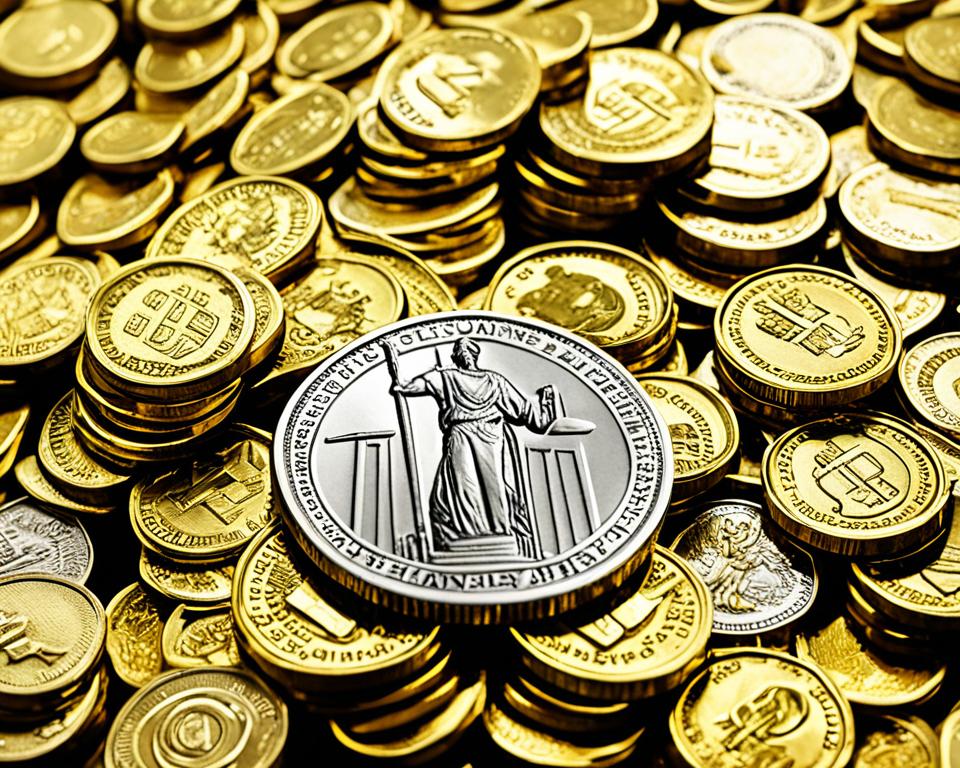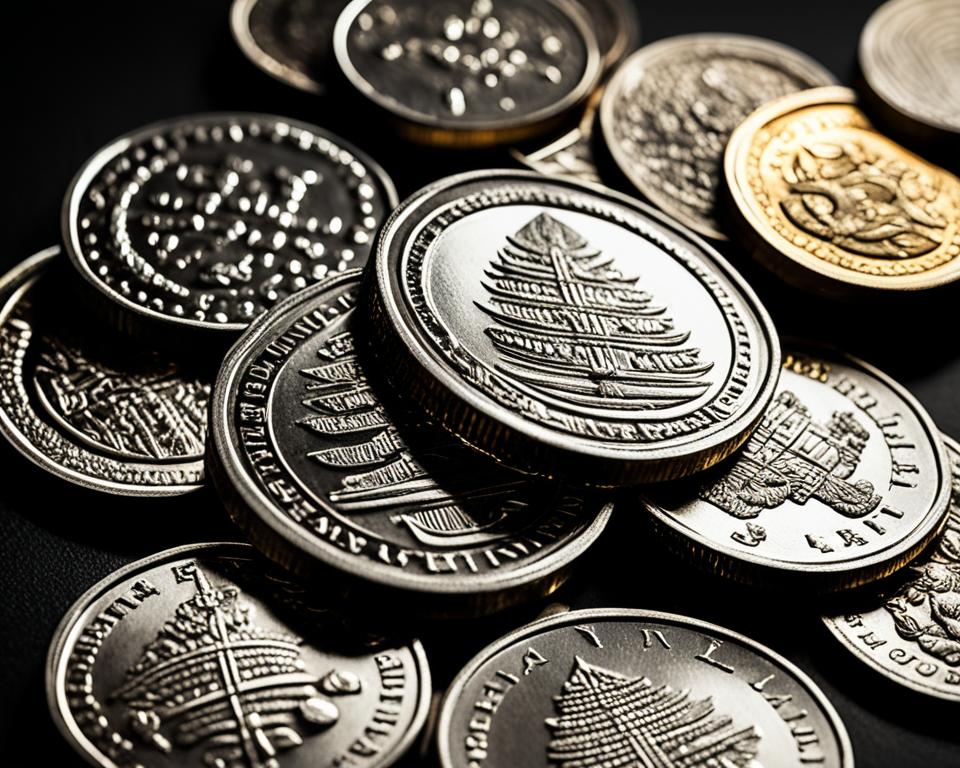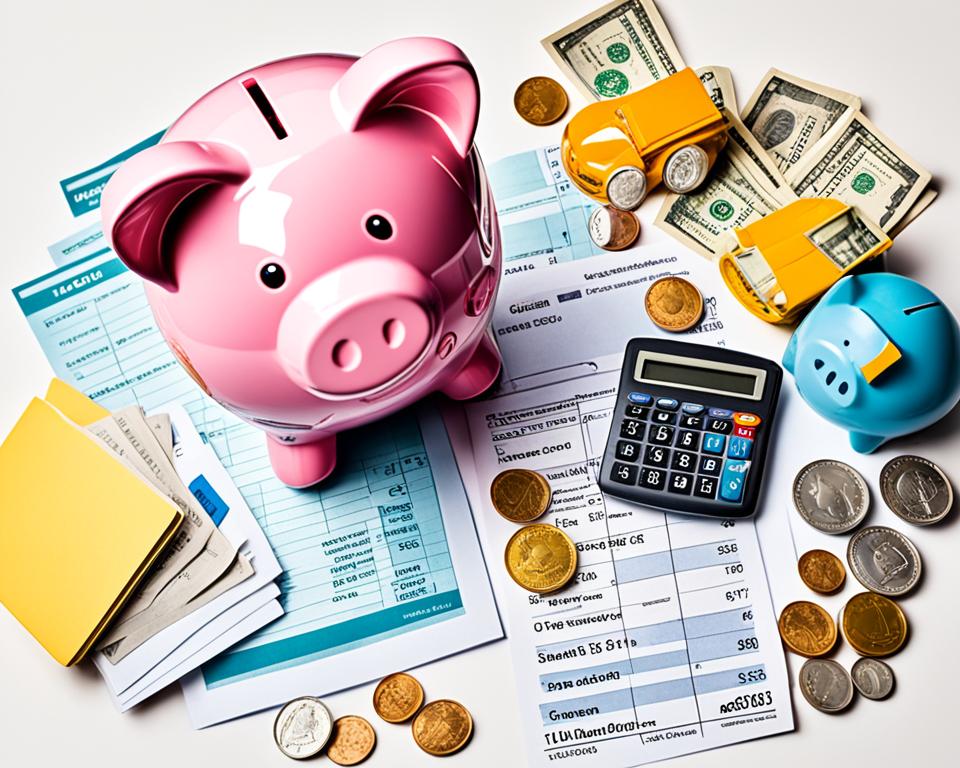Silver is an attractive investment option for beginners looking to diversify their portfolios. If you’re new to the world of investing and interested in silver, this beginner’s guide will provide you with strategies, tips, and advice to make informed decisions.
Investing in silver offers unique opportunities due to its affordability and potential for growth. By understanding the best ways to invest in silver and implementing effective strategies, you can set yourself up for success in the silver market.
Whether you’re a newcomer to investing or a seasoned investor exploring new options, investing in silver can be a rewarding venture. Before diving into the details, let’s explore the benefits of investing in silver and why it may be a valuable addition to your investment portfolio.
Key Takeaways:
- Silver is an attractive investment option for beginners looking to diversify their portfolios
- Investing in silver offers unique opportunities due to its affordability and potential for growth
- Understanding the benefits of investing in silver can help you make informed investment decisions
- Silver serves as a hedge against inflation and can diversify your investment portfolio
- The silver market is impacted by various factors like global supply and demand dynamics
Understanding the Benefits of Investing in Silver
Investing in silver offers a range of benefits that make it an appealing choice for beginners looking to diversify their investment portfolios. With its potential as a hedge against inflation and its historical growth potential, silver presents opportunities for both short-term gains and long-term wealth accumulation.
Silver as a Hedge Against Inflation
Silver has long been recognized as a reliable hedge against inflation, making it an attractive option for investors seeking to protect their wealth from the eroding effects of rising prices. When inflation occurs, the value of paper currency tends to diminish, but the price of silver often rises. By investing in silver, you can preserve the purchasing power of your money and safeguard against the negative impact of inflation.
Silver Diversification Strategy
One of the key advantages of investing in silver is its ability to diversify your investment portfolio. Including silver as part of a diversified portfolio can help reduce overall risk and increase the potential for returns. Silver has historically demonstrated a low correlation with other asset classes, such as stocks and bonds, meaning its value can behave independently. This lack of correlation allows silver to act as a strategic diversification tool, providing stability during market downturns and potentially enhancing overall portfolio performance.
Potential for Silver Price Growth
The potential for silver price growth further adds to its appeal as an investment option. While silver prices can be influenced by various factors, such as industrial demand and global economic conditions, the precious metal has shown resilience and the potential for significant price appreciation over time. As an investor, taking advantage of the potential growth in the silver market can lead to substantial returns.
“Silver has the potential to outperform other traditional investments, offering the possibility of substantial returns.”
To summarize, investing in silver provides several benefits, including its ability to act as a hedge against inflation, its role in diversifying investment portfolios, and its potential for price growth. These advantages make silver an attractive option for beginners looking to enter the world of precious metals investing.
Different Ways to Invest in Silver
When it comes to investing in silver, there are several avenues you can explore. Each option has its own advantages and considerations, allowing you to choose the investment method that aligns with your goals and risk tolerance. Here are some of the different ways you can invest in silver:
1. Physical Silver Bullion and Coins
One of the most traditional ways to invest in silver is by purchasing physical silver bullion or coins. These tangible assets allow you to directly own silver and have it in your possession. Physical silver can be stored at home or in a secure vault, and it offers you the assurance of holding a physical asset.
2. Silver Exchange-Traded Funds (ETFs)
If you prefer a more convenient and liquid investment option, consider investing in silver ETFs. Silver ETFs are investment funds traded on stock exchanges, and they aim to track the performance of silver prices. By investing in silver ETFs, you can gain exposure to the silver market without the need to handle physical silver.
3. Silver Mining Stocks
Another way to invest in silver is by buying shares of silver mining companies. Investing in silver mining stocks allows you to participate in the potential success of these companies. However, it’s important to carefully research and assess the financial health and prospects of the mining companies before making any investment decisions.
Here is a comprehensive table comparing the different ways to invest in silver:
| Investment Method | Advantages | Considerations |
|---|---|---|
| Physical Silver Bullion and Coins | – Direct ownership of tangible assets – Potential for increased value over time |
– Requires storage and security considerations – May incur additional costs for insurance and safekeeping |
| Silver ETFs | – Convenient and liquid investment option – Provides diversification and exposure to the silver market |
– Subject to market volatility and price fluctuations – Involves management fees and potential tracking errors |
| Silver Mining Stocks | – Opportunity to benefit from the success of silver mining companies – Potential for higher returns compared to the price of silver |
– Market and geopolitical risks may impact stock performance – Requires research and analysis of mining company fundamentals |
Quote:
“Investing in silver offers a range of options to suit different investment preferences. Whether you prefer the tangibility of physical silver, the convenience of ETFs, or the potential rewards of silver mining stocks, each investment avenue provides unique benefits. It’s important to carefully evaluate your goals and risk tolerance to determine the most suitable way for you to invest in silver.”
By considering the different ways to invest in silver, you can choose the method that aligns with your investment objectives and risk appetite. Whether you opt for physical silver, ETFs, or mining stocks, silver investments can offer opportunities for growth and diversification in your portfolio.
Understanding Silver Market Volatility
The silver market is characterized by its inherent volatility, with prices subject to fluctuations influenced by various factors. As a beginner investor, comprehending these elements and their impact on silver prices is vital for making informed investment decisions.
Silver Price Volatility:
One of the key aspects of the silver market is its price volatility. Silver prices can experience significant swings within short periods of time, making it crucial for investors to carefully monitor market trends and evaluate potential risks.
Factors Impacting Silver Prices:
Several factors can influence silver prices, including supply and demand dynamics, economic conditions, geopolitical events, and changes in investor sentiment. These elements can contribute to both short-term fluctuations and long-term price trends in the silver market.
Supply and Demand Dynamics:
The supply and demand dynamics in the silver market play a critical role in determining prices. Factors such as mining production, industrial demand, investment demand, and international trade can all impact the balance between supply and demand, exerting influence on silver prices.
Understanding the interconnected relationship between silver supply and demand is essential for beginners to navigate the volatility of the silver market effectively.

By staying informed about the factors impacting silver prices and closely monitoring the supply and demand dynamics in the silver market, beginners can gain insights to help make informed investment decisions.
Developing an Investment Strategy for Silver
When it comes to investing in silver, developing a solid investment strategy is crucial for success. As a beginner, it’s important to consider your investment goals, time horizon, and risk tolerance when formulating your strategy. Whether you’re interested in long-term investments or short-term trading, having a clear plan can help you navigate the ups and downs of the silver market.
First and foremost, define your investment goals. Are you looking to generate steady returns over the long-term, or do you prefer more short-term gains? Understanding your objectives will help shape your investment strategy and determine the appropriate approach.
Next, consider your time horizon. Long-term investments in silver are typically held for several years, taking advantage of the potential for price appreciation over time. On the other hand, short-term investments involve actively buying and selling silver to capitalize on shorter-term price fluctuations.
Managing risk is a crucial aspect of silver investing. Diversification is key to mitigating risk and reducing the impact of market volatility. Consider allocating your portfolio across different types of investments, such as physical silver, silver ETFs, and silver mining stocks. This diversification helps spread your risk and protect your investments from any single market event.
Additionally, consider setting stop-loss orders to manage risk effectively. A stop-loss order is an instruction to sell your silver investment if its price falls below a certain level. This helps limit potential losses and protects your capital in case the market moves against your position.
“Diversification is an essential risk management tool in silver investing.”
Lastly, seeking guidance from a financial advisor or experienced silver investor can provide valuable insights and expertise. They can help you navigate the complex world of silver investing, offer advice on market trends, and help you make informed investment decisions.
Remember, a well-defined investment strategy tailored to your goals, time horizon, and risk tolerance can help you navigate the silver market with confidence and increase your chances of success.
Tips for Developing an Effective Silver Investment Strategy:
- Set clear investment goals tailored to your financial objectives.
- Consider your time horizon and whether you prefer long-term or short-term investments.
- Diversify your portfolio by investing in different types of silver assets.
- Use stop-loss orders to protect your investments from sudden market downturns.
- Seek guidance from a financial advisor or experienced silver investor.
Physical Silver Investments
Investing in physical silver, such as silver coins and bars, is a popular choice for beginners looking to enter the silver market. The allure of owning tangible assets appeals to many investors, providing a sense of security and long-term value. However, before diving into the world of physical silver investments, there are important considerations to keep in mind.
Silver Coins and Bars
Silver coins and bars are two common forms of physical silver investments. Silver coins are often minted by government entities and have a recognized face value, making them highly liquid and easily tradable. They come in various sizes and designs, allowing investors to choose according to their preferences and budget. On the other hand, silver bars are typically produced by private mints and come in larger sizes, offering potentially lower premiums compared to coins.
Storage Considerations
When investing in physical silver, storage is a vital aspect to consider. Proper storage helps protect your investment from theft, damage, or environmental factors that could affect its condition. Many investors opt for secure storage options such as safe deposit boxes or private vaults. These facilities provide a controlled and protected environment for your silver, ensuring its safety and preserving its value over time.
Insurance Considerations
Insurance is another important consideration for physical silver investments. While storage facilities offer security measures, having insurance coverage adds an extra layer of protection against unforeseen events. Consult with insurance providers to explore coverage options and ensure that your investment is adequately protected.
“Investing in physical silver allows you to hold a tangible asset with potential long-term value. However, it’s crucial to consider storage and insurance to safeguard your investment.”
| Pros of Physical Silver Investments | Cons of Physical Silver Investments |
|---|---|
|
|
Investing in physical silver can be a rewarding experience for beginners. By understanding the different forms of physical silver, considering storage and insurance options, and weighing the pros and cons, you can make informed decisions and position yourself for potential long-term growth and financial security.
Silver ETFs and Funds
Investing in silver ETFs and funds is an excellent way for beginners to enter the silver market without actually owning physical silver. These investment vehicles offer a range of advantages, including diversification and liquidity, making them a popular choice among silver investors.
Silver exchange-traded funds (ETFs) and mutual funds are designed to track the performance of the silver market. By investing in these funds, you can gain exposure to silver prices and participate in potential price appreciation.
The Advantages of Silver ETFs and Funds
Silver ETFs and funds offer several benefits:
- Diversification: By investing in silver ETFs and funds, you can gain exposure to the silver market without putting all your eggs in one basket. These investment vehicles typically hold a diversified portfolio of silver assets, reducing the impact of individual asset volatility on your investment.
- Liquidity: Silver ETFs and funds are traded on stock exchanges, providing easy access to your investment. You can buy or sell shares at any time during trading hours, allowing for greater flexibility and liquidity compared to physical silver investments.
- Cost Efficiency: Investing in silver ETFs and funds can be more cost-effective compared to buying and storing physical silver. These investment vehicles typically have low expense ratios, making them an efficient way to invest in silver.
- Transparency: Silver ETFs and funds provide transparency in terms of holdings and performance. You can easily track the value of your investment and monitor how the fund’s assets are allocated.
Whether you choose silver ETFs or mutual funds, carefully consider your investment goals, risk tolerance, and investment strategy. Conduct thorough research and compare different options before making a decision.
To further illustrate the advantages of silver ETFs and funds, consider the following table:
| Advantages | Silver ETFs | Silver Mutual Funds |
|---|---|---|
| Diversification | ✅ | ✅ |
| Liquidity | ✅ | ✅ |
| Cost Efficiency | ✅ | ✅ |
| Transparency | ✅ | ✅ |

As displayed in the table above, silver ETFs and silver mutual funds offer similar advantages, making them attractive options for silver investors. The choice between the two will depend on your personal preferences, investment strategy, and specific fund details.
In the next section, we will explore another investment option for beginners: investing in silver mining stocks.
Investing in Silver Mining Stocks
When it comes to investing in the silver market, one option that beginners can consider is investing in silver mining stocks. By purchasing shares of silver mining companies, you can potentially benefit from the success and growth of these companies in the silver industry.
However, before making any investment decisions, it is essential to carefully assess various factors related to silver mining stocks. Here are some key factors to consider when investing in silver mining stocks:
- Financial health of the company: Analyzing the financial health of a silver mining company is crucial. Look at factors such as revenue, profits, debt levels, and cash flow. A financially stable company is more likely to weather market fluctuations and have a higher potential for growth.
- Management team: The expertise, experience, and track record of the management team can significantly influence the success of a silver mining company. Research the background of the management team and evaluate their ability to navigate the challenges and opportunities in the silver industry.
- Exploration and production: Consider the company’s exploration and production activities. Evaluate their mining assets, reserves, and production capabilities. A company with promising exploration projects and efficient production processes may have a higher chance of increasing their silver output and profitability.
“Investing in silver mining stocks can provide exposure to the potential growth of the silver industry. However, it’s important to conduct thorough research and consider various factors before making investment decisions.” – [Your Name]
It’s also worth noting that investing in silver mining stocks comes with certain risks. The silver market is subject to price volatility, and individual mining companies may face operational challenges or other industry-specific risks. Therefore, it’s crucial to diversify your investment portfolio and carefully assess the risks associated with investing in silver mining stocks.
To make informed investment decisions in this sector, it can be helpful to consult with a financial advisor who specializes in precious metals investments. They can provide valuable insights and guidance based on their expertise and market knowledge.
By considering these factors and seeking professional advice, beginners can navigate the world of silver mining stocks and potentially capitalize on the growth opportunities in the silver industry.
Key Factors to Consider When Investing in Silver Mining Stocks
| Factors | Description |
|---|---|
| Financial Health | Assess the company’s financial stability, revenue, profits, debt levels, and cash flow. |
| Management Team | Evaluate the expertise, experience, and track record of the company’s management team. |
| Exploration and Production | Analyze the company’s mining assets, reserves, and production capabilities. |
Image: Investing in silver mining stocks provides an opportunity for beginners to participate in the success of silver mining companies. However, careful assessment of various factors is essential for making informed investment decisions.
Understanding the Silver Market and Industry
Staying knowledgeable about the silver market and industry is crucial for successful investing. Monitoring market trends, understanding supply and demand dynamics, and keeping an eye on factors influencing the silver market can assist beginners in making informed investment decisions.
Market trends play a significant role in shaping the silver industry outlook. By analyzing past and current trends, investors can gain valuable insights into the potential future performance of silver. For instance, if there is an increasing demand for silver in industries such as electronics or renewable energy, it can indicate a positive market outlook and the potential for price appreciation.
Supply and demand dynamics are also critical factors to consider when examining the silver market. Changes in silver production and consumption can have a direct impact on prices. For example, if silver mining yields decrease while demand remains steady, it can lead to a supply shortage and potentially drive prices upward.
Keeping an eye on factors that influence the silver market is essential for investors to stay ahead. Economic indicators, geopolitical events, and monetary policies are just a few examples of the factors that can significantly affect silver prices. Regularly researching and analyzing these factors can help investors anticipate market movements and make informed investment decisions.
Understanding the silver market and industry requires continuous learning and staying updated with the latest news and developments. Analyzing market reports, following industry experts, and engaging in online communities can provide valuable insights and help investors navigate through the complexities of the silver market.
| Market Trends | Supply and Demand Dynamics | Factors Influencing the Silver Market |
|---|---|---|
| Understanding the historical and current trends in the silver market | Evaluating the balance between silver supply and demand | Analyzing economic indicators, geopolitical events, and monetary policies |
| Identifying potential future performance and growth opportunities | Recognizing potential supply shortages or surpluses | Anticipating market movements and price fluctuations |
Risk Management in Silver Investing
Managing risk is crucial when it comes to investing in silver. As a beginner, it’s important to implement effective risk management strategies in order to protect your investments and minimize potential losses. Here are some key strategies to consider:
Diversification Strategies
Diversifying your portfolio is a fundamental aspect of risk management in silver investing. By spreading your investments across different asset classes, industries, and geographical regions, you can reduce the impact of silver price fluctuations on your overall portfolio. Consider allocating a portion of your investment capital to other precious metals, stocks, bonds, or real estate, depending on your risk tolerance and investment goals.
Setting Stop-Loss Orders
Setting stop-loss orders is a proactive risk management technique. A stop-loss order is an instruction to sell a security (such as silver) when it reaches a specific price level, limiting potential losses. By defining your risk tolerance and setting appropriate stop-loss levels, you can protect your investments from significant downturns in silver prices. It’s important to regularly review and adjust your stop-loss orders in response to market conditions and the performance of your investments.
Consulting a Financial Advisor
Seeking guidance from a qualified financial advisor can provide invaluable support in managing risk. A financial advisor can help assess your financial situation, understand your investment objectives, and provide personalized advice based on your individual needs. They can also help you navigate the complexities of the silver market, identify potential risks, and develop a customized risk management strategy that aligns with your goals.
“A skilled financial advisor can provide you with the expertise and insights needed to make informed investment decisions in the silver market.”
Remember, risk management is an ongoing process that requires regular monitoring and adjustment. Stay informed about market developments, monitor changes in silver prices, and adjust your investment strategy accordingly. By implementing these risk management strategies and seeking professional guidance, you can position yourself for success in silver investing.
| Risk Management Strategies | Advantages |
|---|---|
| Diversification | Reduces reliance on silver prices and minimizes potential losses |
| Stop-Loss Orders | Limits losses by automatically selling silver at pre-defined price levels |
| Consulting a Financial Advisor | Access to professional guidance and personalized risk management strategies |
Tips for Successful Silver Investing
When it comes to silver investing, there are certain tips and best practices that beginners should follow. By implementing these strategies, you can increase your chances of achieving profitable investments and navigate the silver market with confidence. Here are some essential tips to keep in mind:
- Stay Informed: To make informed investment decisions, it’s crucial to stay updated on the latest developments in the silver market. Regularly monitor market trends, news, and industry insights to gain a comprehensive understanding of the dynamics that can impact silver prices.
- Learn from Experienced Investors: Learning from experienced investors who have a proven track record in silver investing can provide valuable insights and guidance. Read books, follow reputable blogs, and attend industry conferences to gain knowledge from those who have successfully navigated the silver market.
- Conduct Thorough Research: Before making any investment, conduct thorough research into the silver market, including historical price trends, supply and demand factors, and geopolitical influences. This research will empower you to make informed investment decisions and mitigate risks.
- Diversify Your Portfolio: Diversification is key to managing risk in any investment portfolio. Consider allocating a portion of your investment funds to silver to enhance portfolio stability and potential returns. By spreading your investments across different asset classes, you can minimize the impact of market fluctuations.
- Set Realistic Goals: Before entering the silver market, set realistic investment goals. Determine your risk tolerance and desired investment timeline to develop a strategy tailored to your financial objectives. Setting clear goals will help you stay focused and disciplined in your silver investing journey.
- Monitor Silver Supplies: Keep a close eye on silver supplies, as fluctuations in supply can impact silver prices. Understanding supply and demand dynamics can provide valuable insights into potential price movements and help you make well-timed investment decisions.
- Stay Patient: Investing in silver requires patience. Price fluctuations are a natural part of the market, and it’s important not to make hasty decisions based on short-term price movements. Stay focused on your long-term investment strategy and avoid succumbing to emotional impulses.
By following these tips and best practices, you can enhance your chances of success in silver investing. Remember that continuous learning, staying informed, and adapting your strategy to changing market conditions are essential for long-term profitability.
| Tips for Successful Silver Investing |
|---|
| Stay Informed |
| Learn from Experienced Investors |
| Conduct Thorough Research |
| Diversify Your Portfolio |
| Set Realistic Goals |
| Monitor Silver Supplies |
| Stay Patient |
Conclusion
Investing in silver can be a beneficial and rewarding venture for beginners. With its affordability and potential for growth, silver offers a unique opportunity to diversify your investment portfolio. By understanding the various investment options available, developing a sound investment strategy, and staying informed about the silver market, you can embark on a successful silver investment journey.
When investing in silver, it is important to assess your own risk tolerance and financial goals. Consider factors such as your investment timeline, desired returns, and the level of risk you are comfortable with. By doing so, you can tailor your approach to silver investing accordingly.
In conclusion, silver investment for beginners can provide long-term value and serve as a solid foundation for your investment portfolio. Remember to stay informed, seek expert advice when needed, and continuously evaluate your investment strategy. With dedication and a well-thought-out approach, you can navigate the silver market with confidence and potentially reap the rewards of your investments.
FAQ
How can beginners invest in silver?
Beginners can invest in silver through various methods, including purchasing physical silver bullion or coins, investing in silver ETFs, or buying shares of silver mining companies.
What are the benefits of investing in silver?
Investing in silver offers benefits such as hedging against inflation, diversifying investment portfolios, and the potential for growth in silver prices.
What are the different ways to invest in silver?
There are several ways to invest in silver, including buying physical silver bullion or coins, investing in silver ETFs or funds, or purchasing shares of silver mining companies.
How does silver market volatility impact investments?
The silver market is known for its volatility, with prices influenced by factors such as global supply and demand dynamics. Understanding market volatility is important for making informed investment decisions.
How can beginners develop an investment strategy for silver?
Beginners should consider their investment goals, time horizon, and risk tolerance when creating a silver investment strategy. This strategy will guide their decision-making process and help navigate market fluctuations.
What should beginners consider when investing in physical silver?
Beginners should consider factors such as storage and insurance options when investing in physical silver. Proper safeguarding of these assets is important to protect their value.
What are silver ETFs and how can beginners invest in them?
Silver ETFs are investment funds that track the performance of silver prices. Beginners can invest in silver ETFs by purchasing shares through a brokerage account.
What factors should beginners consider when investing in silver mining stocks?
Beginners investing in silver mining stocks should carefully assess the financial health and prospects of silver mining companies. Factors such as production costs, reserves, and management track record are important considerations.
How can beginners stay informed about the silver market?
Staying knowledgeable about the silver market involves monitoring market trends, understanding supply and demand dynamics, and staying updated on factors that influence the silver market.
How can beginners manage risks in silver investing?
Beginners can manage risks in silver investing by diversifying their portfolios, setting stop-loss orders to limit losses, and seeking guidance from a financial advisor.
What are some tips for successful silver investing?
Tips for successful silver investing include staying informed about the silver market, learning from experienced investors, conducting thorough research, and following best practices in silver investing.





